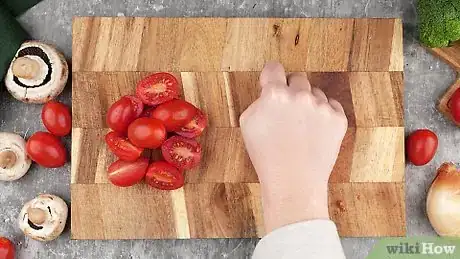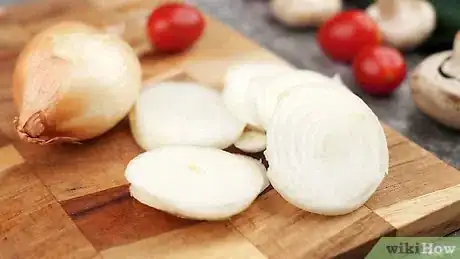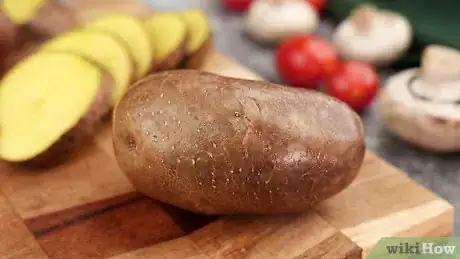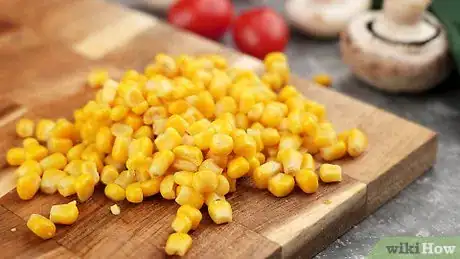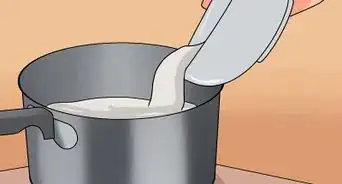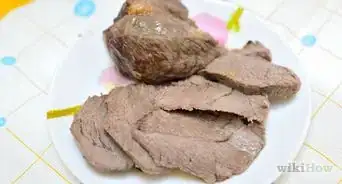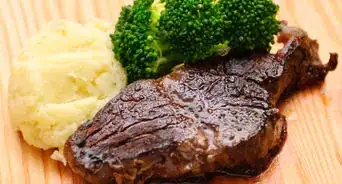This article was co-authored by wikiHow staff writer, Hunter Rising. Hunter Rising is a wikiHow Staff Writer based in Los Angeles. He has more than three years of experience writing for and working with wikiHow. Hunter holds a BFA in Entertainment Design from the University of Wisconsin - Stout and a Minor in English Writing.
There are 12 references cited in this article, which can be found at the bottom of the page.
The wikiHow Video Team also followed the article's instructions and verified that they work.
This article has been viewed 50,489 times.
Learn more...
When a recipe calls for vegetables in cups, you might be confused trying to figure out how much you actually need to add. Luckily, using a measuring cup to find the right amount of veggies isn't too difficult at all. Since your measurements will vary a bit depending on the vegetables you're using, we'll cover how to accurately find the right amount and go over some common conversions so you can finish your meal!
Steps
Portion Sizes
-
1Choose a portion that’s about the size of your fist or a baseball. If you don’t have a measuring cup or are in a hurry, make a fist and compare it to the overall amount of your vegetables. If your veggies are roughly the same size, then you have about 1 cup. This works with any type of vegetable, so it doesn’t matter if you’re measuring them when they’re raw, cooked, or frozen.[1]
- If you’re working with long vegetables, such as carrots or celery, chop them up first to get a more accurate estimation.
-
2Pack your veggies into a measuring cup for an accurate measurement. You can use a measuring cup whether they’re raw, cooked, or frozen since they’ll have a similar volume. Start by roughly chopping your veggies so they can fit into your measuring cup. As you add your vegetables, shake the measuring cup or push the veggies down with your hands to fill in air pockets. Once your vegetables are level with the top of your measuring cup, then you’re finished![2]
- Avoid smashing your vegetables when you pack them down, or else you might have an inaccurate measurement.
- Even though a standard measuring cup is equivalent to 8 ounces (230 g), vegetables have different densities so they may weigh more or less than that. Avoid assuming that 8 ounces (230 g) of a veggie is the same as 1 cup.[3]
Advertisement -
3Use 2 packed cups of raw leafy vegetables to equal 1 cup. Veggies like lettuce, spinach, watercress, and endive leave empty space in a measuring cup, so 1 full measuring cup is actually a ½ cup serving. Fill your measuring cup to the rim a second time any time you use these vegetables if you want a serving that’s equivalent to a full cup.[4]
- If you’re working with cooked leafy vegetables, then you only need to fill your measuring cup once.
-
4Fill ½ cup with dried vegetables for a 1 cup equivalent serving. Dried vegetables don’t have as high of a moisture content, so they’re more dense than fresh veggies. If a recipe calls for a cup of any dried veggies, only use a half cup instead since they’ll rehydrate and expand.[5]
- You don’t need to rehydrate vegetables before using them if you’re using a recipe that you need to cook. Otherwise, simmer the vegetables in water for 10–15 minutes or let them soak for 1–2 hours.[6]
-
5Aim to have 2–3 cups of vegetables every day.[7] Your average serving of vegetables weighs about 4–6 ounces (110–170 g), but the amount in cups depends on what you’re eating. Spread your vegetable servings throughout the day so you have some with each of your meals. You can even prepare a few healthy snacks, such carrot or celery sticks to help curb your hunger throughout the day.[8]
- Vegetables make great side dishes, but they’re also so easy to incorporate into your recipes. For example, you can add fresh vegetables to pasta sauces or sandwiches.
Vegetable Equivalents
-
1
-
2
-
3Bell pepper: chopping 1 large bell pepper that’s 3 in (7.6 cm) long will give you about a cup.[13]
-
4Onion: slice a medium-sized onion, or 1⁄2 lb (230 g), for 2 cups raw, which will turn into 1 cup when you cook them down.[14]
-
5
-
6Potato: a large baked potato that weighs about 10 ounces (280 g) is about the same as a cup.[17]
-
7Sweet potato: use 1 large sweet potato, or 1 pound (450 g), for your measurement.[18]
-
8
-
9Corn: an 8–9 in (20–23 cm) ear of corn will fill a cup when you cut it off of the cob.[21]
Warnings
- Avoid converting weight to cups since vegetables have different densities, so 1 cup of one veggie may weigh more than a cup of a different variety.[23]⧼thumbs_response⧽
References
- ↑ https://www.eatright.org/food/nutrition/nutrition-facts-and-food-labels/serving-size-vs-portion-size-is-there-a-difference
- ↑ https://www.hudsonvalley.va.gov/features/Healthy_Eating.asp
- ↑ https://fruitsandveggies.org/expert-advice/weigh-one-cup-ounces/
- ↑ http://cherokeepublichealth.org/wp-content/uploads/2015/07/vegetables-counts.pdf
- ↑ https://www.hudsonvalley.va.gov/features/Healthy_Eating.asp
- ↑ https://www.harmonyhousefoods.com/assets/images/default/PDFs/rehydrate_chart.pdf
- ↑ https://www.myplate.gov/eat-healthy/vegetables
- ↑ https://www.mayoclinichealthsystem.org/hometown-health/speaking-of-health/123-approach-to-eating-fruits-and-vegetables
- ↑ https://www.myplate.gov/eat-healthy/vegetables
- ↑ https://www.almanac.com/content/measuring-vegetables-recipes-pounds-cups#
- ↑ https://www.myplate.gov/eat-healthy/vegetables
- ↑ https://www.fdacs.gov/content/download/78951/file/FNW-FRUITVEGREFGUIDE-FLYER-2019-FINAL.PDF
- ↑ https://www.myplate.gov/eat-healthy/vegetables
- ↑ https://www.almanac.com/content/measuring-vegetables-recipes-pounds-cups#
- ↑ http://cherokeepublichealth.org/wp-content/uploads/2015/07/vegetables-counts.pdf
- ↑ https://www.tn.gov/health/health-program-areas/fhw/mch-nutrition/what-counts-as-a-cup.html
- ↑ https://www.fdacs.gov/content/download/78951/file/FNW-FRUITVEGREFGUIDE-FLYER-2019-FINAL.PDF
- ↑ https://snaped.fns.usda.gov/sites/default/files/documents/VegetablesandFruits_SimpleSolutionsHandouts.pdf
- ↑ http://cherokeepublichealth.org/wp-content/uploads/2015/07/vegetables-counts.pdf
- ↑ https://www.almanac.com/content/measuring-vegetables-recipes-pounds-cups#
- ↑ http://cherokeepublichealth.org/wp-content/uploads/2015/07/vegetables-counts.pdf
- ↑ https://www.myplate.gov/eat-healthy/vegetables
- ↑ https://fruitsandveggies.org/expert-advice/weigh-one-cup-ounces/
About This Article
Using a recipe that measures vegetables in cups? If you have a measuring cup on hand, chop your veggies up before pouring them in. Be careful not to mash them down. Instead, shake the cup lightly to help them settle. For light, leafy vegetables, like spinach, keep in mind that 1 full cup is actually equivalent to about a ½ cup serving. The opposite is true for dried vegetables, which are denser than fresh ones. Don’t have a measuring cup? Make a portion of fresh, frozen, or cooked veggies that’s about the size of your fist.
